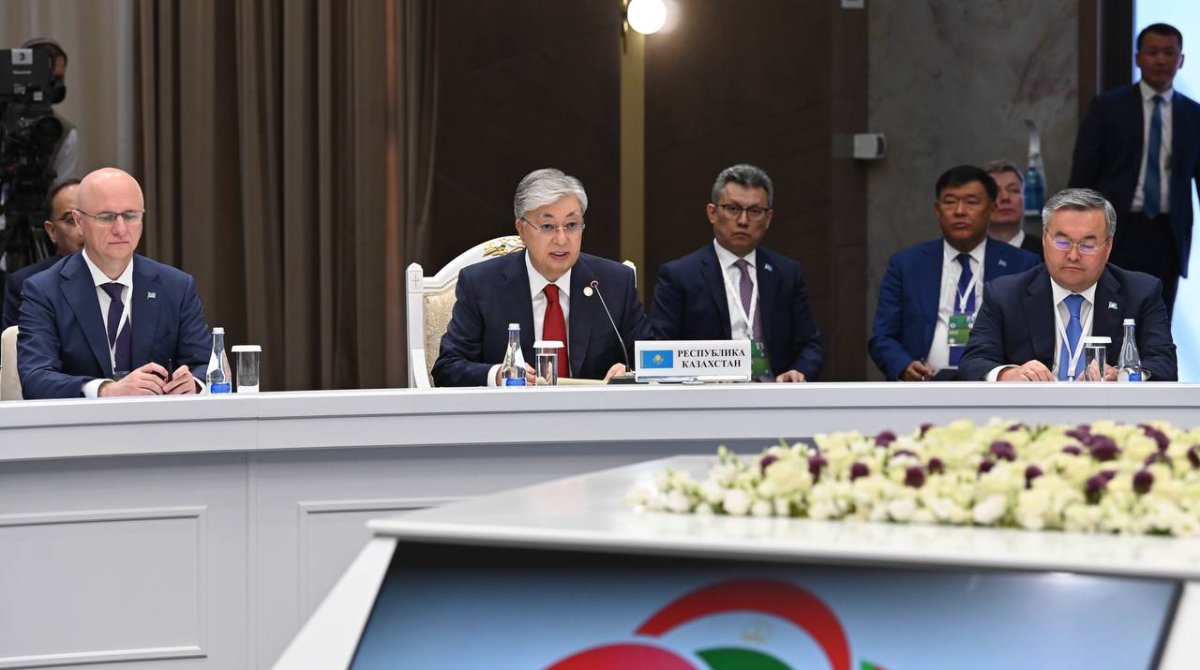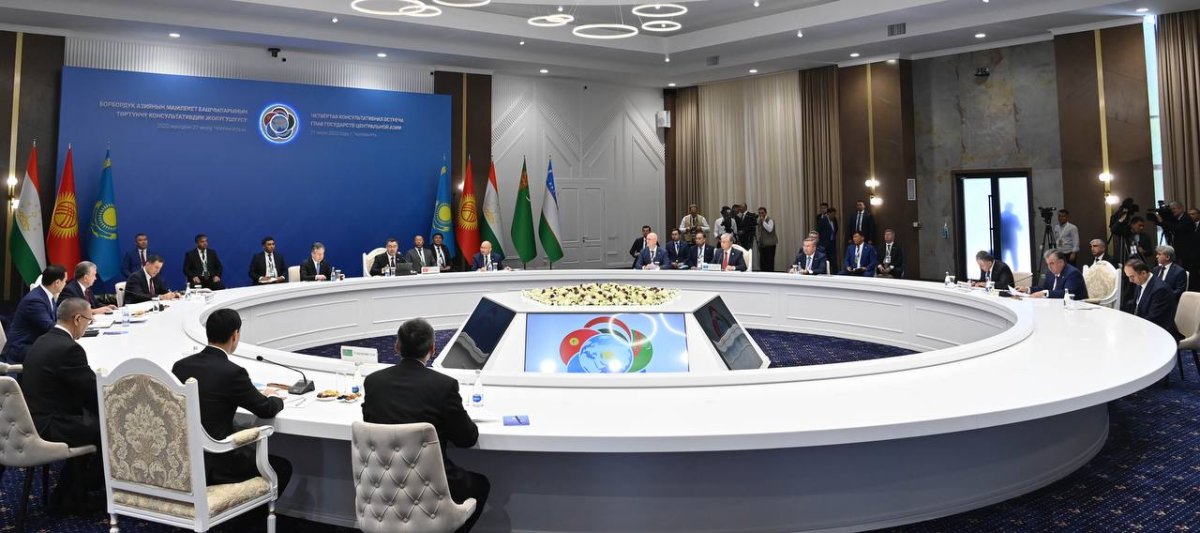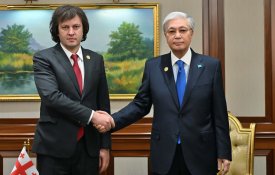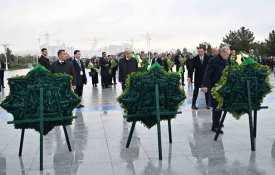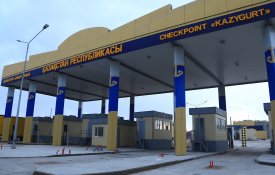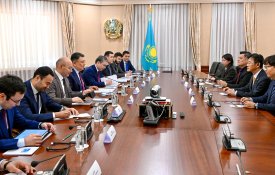Following the July 21 Heads of Central Asian States meeting in Cholpon-Ata, the Presidents of Kazakhstan, Kyrgyzstan, Tajikistan, Turkmenistan, and Uzbekistan, adopted and published a Joint Statement. The five leaders approved a Roadmap for Regional Development and Cooperation for the years 2022-2024; the Concept of Interaction between the States of Central Asia within the Framework of Multilateral Formats; and the Regional Green Agenda Program for Central Asia.
In addition, the Treaty between the Republics of Kazakhstan, Kyrgyzstan, Tajikistan, Turkmenistan, and Uzbekistan on Friendship, Goodneighborliness, and Cooperation for the Development of Central Asia in the 21st Century was agreed upon, as well as a multilateral decision to promote further the International Fund for Saving the Aral Sea.
The President of Kazakhstan, Kassym-Jomart Tokyev, focused his remarks at the summit on five essential issues for Central Asia. Noting the importance of increasing regional cooperation, he stated that “the most important mission of Central Asia is to build bridges between the competing poles of global politics and economics.”
“Due to the conditions of geopolitical turbulence and instability of the world economy”, he noted, “our meeting demonstrates the solidarity of the Central Asian countries, and the common desire to jointly confront new challenges and threats. All-round rapprochement of our states is conditioned by the dictates of the time and fully meets the fundamental interests of the fraternal peoples. Since the first Consultative Meeting in Kazakhstan in 2018, regional cooperation has been steadily strengthening in all directions. Interstate political dialogue has reached a qualitatively new level, setting the tone for the dynamic development of relations in the spirit of genuine good-neighborliness and alliance”.
“The mutually beneficial trade and economic cooperation are steadily expanding. Through our joint efforts, it was possible not only to restore the pre-pandemic level of engagement but also to significantly increase trade turnover. According to our data, last year the volume of intra-regional trade grew by 27 percent, exceeding US$ 8 billion. Active cultural and humanitarian ties remain an unshakable foundation of long-term relations between the states of Central Asia. Cross-cultural days, large-scale forums, and exhibitions are held regularly, joint scientific-historical research is organized, and student exchanges are actively carried out, among other initiatives”.
“The Treaty of Friendship, Good-Neighbourliness and Cooperation for Development of Central Asia in the Twenty-First Century, which is unique in its content and historical perspective, enshrines the special nature of our relations. Ensuring sustainable development, stability, and security of the region is a common task, which implies a great responsibility before future generations. I would like to assure you that Kazakhstan remains committed to the strategic course of comprehensive strengthening of regional cooperation and enhancing Central Asia’s role in the global arena”.
“The countries of the region have been acting with dignity during the critical period of growing international tension. Our pragmatic and balanced foreign policy is contributing to this. Since time immemorial, the territories of our countries served as an important link between civilizations. And today the most important mission of Central Asia, in my opinion, is to build bridges between the competing poles of global politics and economics. Sooner or later the period of geopolitical confrontation will end, but the bridges built will remain. They will become an invaluable legacy for future generations of our fraternal peoples. Given our common interests, I propose to focus on the following fundamental tasks”.
Strengthening Cooperation in Security and Diplomacy
“First, strengthening cooperation in security and diplomacy remains a key agenda item. This is imperative to ensure proper conditions for the prosperity of the peoples of Central Asia. The region must become a vast area of sustainable socio-economic development, comprehensive cooperation, peace, and prosperity. A mechanism of regular consultations of the Secretaries of the Security Councils should be launched to jointly work out solutions for preventing security threats. In addition, I propose that ministers of foreign affairs should be instructed to meet regularly, at least once every six months, to develop coordinated approaches to key regional and international issues”.
“With regard to cooperation with non-regional strategic partners, Kazakhstan considers it possible to adopt a Concept of Cooperation of Central Asian States within the framework of multilateral formats. In my opinion, we should not remain confined within fixed geographical limits. The Consultative Meetings of Central Asian Leaders could be attended by high-ranking representatives of other neighboring states, such as Russia and China, as invited guests. I am confident that this would benefit the countries of Central Asia, especially when dealing with specific issues”.
Eliminating Factors of Instability in the Region
“Second, we, the leaders of the states, must do our best to eliminate as much as possible the remaining factors of instability in the region. Every shot fired at interstate borders echoes heavily not only in the countries involved but also throughout the region. On the contrary, it is in the current crisis conditions that our states must demonstrate an example of the civilized, responsible overcoming of contradictions. We know from our own experience that the process of legal registration of borders is very difficult and thorny. The resolution of disputed issues is possible only through peaceful means, in the spirit of genuine good neighborliness and respect for the fundamental principles of international law. There is no alternative”.
“Kazakhstan, as the only post-Soviet state that has completely delimited its long border, is ready to provide all possible assistance in finding mutually acceptable solutions. In particular, we propose to create an expert platform to develop mutually acceptable approaches to border delimitation. Experienced lawyers, cartographers, border guards, and other specialists should be involved in this work, and the Council of Ministers of Foreign Affairs could coordinate it”.
Formation of Economic Foundation for Regional Cooperation
“Third, The formation of a solid economic foundation for multilateral cooperation remains an urgent task. In recent years, tangible results have been achieved in this area. Over the last five years, Kazakhstan’s trade turnover with other Central Asian countries has grown by 42 percent, reachingUS$ 6.3 billion. Taking into account the huge reserves for increasing mutual trade, in the foreseeable future it is desirable to bring this figure up to US$ 15 billion. The threat of an impending global recession, largely triggered by the “sanctions wars” and growing protectionism, brings to the fore the issue of accelerated development of regional economic cooperation.
As production and trade supply chains are collapsing, the trend toward regionalization is becoming increasingly pronounced everywhere. Against this background, the trade figures I have cited between our countries still do not reflect our full potential”.
“Central Asian economic cooperation may well become, if not the main, then at least one of the key sources of growth of our national economies. To fully use the economic potential and benefits of the advantageous geographical position, it is important to establish close cooperation to eliminate structural and infrastructural constraints. It would be practically useful to take effective measures to launch a network of cross-border trade and economic hubs that would serve as anchor points of the Common Goods Transmission System of Central Asian countries with the prospect of its further expansion”.
“Kazakhstan is already taking practical steps in this direction with its Kyrgyz and Uzbek partners. In particular, the project of the International Centre for Industrial Cooperation ‘Central Asia’ is being implemented on the Kazakh-Uzbek border, as is the Industrial Trade and Logistics Complex on the Kazakh-Kyrgyz border. There is an agreement with Tajikistan to create wholesale and distribution centers, and together with Turkmenistan, we plan to build a grain terminal. These projects meet our common interests in increasing the volume of mutual trade turnover, as well as the export of products to the markets of the Eurasian Economic Union (EAEU) and other countries”.
“Along with traditional approaches, it is necessary to make wider use of modern ways to increase exports. In particular, recent widespread restrictions and lockdowns have shown the extreme importance of developing e-commerce. Given the competitive position of Central Asian countries, Kazakhstan initially proposes to organize joint product promotion at upcoming online exhibitions. There is more potential. Strengthening socio-economic stability in the region now largely depends on effective measures to attract investment. According to international experts, our aggregate potential to attract foreign direct investment over the next 10 years is estimated at up to US$ 170 billion, including in non-resource industries – about US$ 70 billion”.
“In this context, the Astana International Financial Centre (AIFC) could become an effective platform for stimulating direct and portfolio investments into regional projects. AIFC combines the best experience of global financial institutions and the latest tools. More than 1,400 companies from 64 countries are registered at the AIFC. Furthermore, most foreign participants of the AIFC are interested in doing business not only in Kazakhstan but also in neighboring countries. We are open to any format of bilateral and multilateral cooperation on the AIFC platform”.
Increasing the Region’s Transportation Routes
“Fourth, it is necessary to increase the region’s transport connectivity and consistently improve transit conditions. Even a cursory glance at the map shows the unique geographical location of Central Asia at the junction of [roures between] Russia, China, South Asia, the Middle East, and the South Caucasus. In the new geopolitical realities, the role of our region in promoting and developing transcontinental trade is increasing rapidly”.
“Kazakhstan is actively developing the Trans-Caspian International Transport Route. Since 2017, the number of transported containers along the routes of this corridor has increased almost threefold, to 25,000. In addition, Kazakhstan is ready to participate in the construction of the Mazar-e-Sharif - Kabul - Peshawar railroad. In particular, we can provide an uninterrupted supply of track structure materials and rolling stock. For our part, we call on our partners to actively use the railroad ‘Kazakhstan - Turkmenistan - Iran’, the shortest route between East Asia and the countries of the Persian Gulf”.
“During my recent visit to Iran, the first container train from Kazakhstan to Turkey was launched via Turkmenistan and Iran. This new logistics solution enables us to cover over 6,000 kilometers in just 12 days. The Kazakh seaports of Aktau and Kuryk can provide access to the markets of the Middle East and Europe. I am sure Turkmenistan, which is successfully developing the infrastructure of Turkmenbashi port, holds the same position. At the same time, our countries must not lose sight of the issues of development of transport communications between each other. Currently, we are actively cooperating with Uzbekistan. The launch of the railway line “Darbaza - Maktaral” will double the traffic capacity and reduce the time of cargo transportation by 1.5 times”.
“We also support the construction of a new ‘Turkmenbashi - Garabogaz - border of Kazakhstan’ highway. There are plans to begin work on the reconstruction of the ‘Zhanaozen - border of Turkmenistan’ road section from 2025. Coordination of activities in this area would significantly increase the impact of our transport and logistics projects. Therefore, the governments should closely cooperate on optimizing the tariff policy and simplifying administrative procedures for transit traffic”.
Establishing a Multilateral Central Asian Environmental Office
“Fifth, contemporary climatic challenges and growing demand for water and energy resources require decisive measures to ensure rational use of water resources in the Aral Sea basin. According to the report of the International Panel on Climate Change, the temperature in our region is rising much faster than the global average. Climate change processes are reducing the area of glaciers, the main source of water for our region. Over the past 50 years, the volume of glaciers in Central Asia has reduced by 20-30%, which in the future will decrease the flow of the Syr Darya and Amu Darya by several times”.
“All this entails serious risks to food, energy, and environmental security in the region, requiring the adoption of urgent joint measures. In this context, we welcome Kyrgyzstan’s initiative to declare 2022 the International Year of Sustainable Mountain Development. In addition, we consider Tajikistan’s proposal to declare 2025 the International Year of the Preservation of Glaciers to be timely”.
“I am deeply convinced that it is no longer possible to overcome the consequences of climate change in Central Asia without consolidating our efforts. Therefore, in order to coordinate joint actions, we propose to establish a Central Asian project office for environmental protection and implementation of a coordinated policy on climate change in the region”.
I would like to take this opportunity to provide some interesting facts on this pressing issue. The special report of the Intergovernmental Panel on Climate Change of 1.5 degrees Celsius predicts an increase in temperature in Central Asia by the end of the century by 6 degrees Celsius. This is double the predicted global temperature increase. There are currently 2,724 glaciers in Kazakhstan. The largest, Tuyuksu, has shrunk by 1 km in the past 38 years. It loses about 1 million tons of its volume, amounting to 58 million tons, annually. This will lead to a reduction of water resource volume by more than 20% by 2040”.
“Kazakhstan also attaches particular importance to the implementation of joint hydropower projects for the mutually beneficial use of water resources of transboundary rivers. In this context, the Kambarata HPS-1 project in Kyrgyzstan is being actively discussed. Yesterday we, the three presidents [of Kazakhstan, Kyrgyzstan, and Uzbekistan], discussed this issue in detail and came to preliminary specific and very useful agreements. The hydroelectric power station will strengthen the energy security of the Central Asian countries and improve conditions for the expansion of agricultural production. We also call for increased engagement between the countries within the framework of the International Fund for Saving the Aral Sea”.
“I believe that the outcome of today’s summit will open a new page in the development of regional cooperation for peace, security, and progress in Central Asia”, The President of Kazakhstan concluded. “Kazakhs say: ‘Tatulyk – tausylmas bakyt’, which means, ‘Friendship is an inexhaustible wealth’. I am sure that close trusting relations tested by time and common historical and spiritual roots will always be an inexhaustible source of friendship between our countries.


